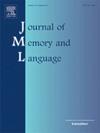一生的阅读经历有助于感知拥挤的字母
IF 3
1区 心理学
Q1 LINGUISTICS
引用次数: 0
摘要
当物体被其他物体紧紧挤在一起时,视觉感知通常会受损。这可能会使阅读变得非常困难,因为字母在单词中紧密地挤在一起。然而,一生的阅读经历可能会导致视觉处理的变化,从而减少拥挤对字母的影响。研究1通过比较60名有经验的英语读者对正字母、倒字母和Gabor贴片的拥挤阈值(以产生82%正确率的最接近间距来衡量),通过实验检验了这一假设。我们发现,与其他类型的刺激相比,直立字母的拥挤阈值降低了,特别是对于靠近中央凹的刺激。换句话说,有经验的读者可以忍受高度熟悉的直立字母比不太熟悉的刺激类型更小的间距。拥挤阈值也降低到注视的右侧,与从左到右的英语阅读方向相匹配。研究2测量了250名观察者的拥挤程度,并询问阅读体验的个体差异是否与拥挤程度降低有关。我们发现,在这些替代测量中得分越高,直立字母的拥挤阈值越低,尤其是在右侧视野中。这些结果提供了证据,表明一生的阅读经历会改变视觉感知的各个方面,例如直立的字母可以在更拥挤的条件下被感知,而不是在其他刺激下。在实际层面上,这意味着对于有经验的读者来说,字母拥挤的有害影响显着减少,这对视觉拥挤和阅读模型都有影响。本文章由计算机程序翻译,如有差异,请以英文原文为准。
A lifetime of reading experience facilitates the perception of crowded letters
Visual perception is ordinarily impaired for objects that are tightly crowded by other objects. This might be expected to make reading very difficult given that letters are tightly crowded together within words. However, a lifetime of reading experience may lead to changes in visual processing that reduce the effects of crowding on letters. Study 1 examined this hypothesis experimentally by comparing crowding thresholds (measured as the closest spacing that yields recognition accuracy of 82% correct) for upright letters, inverted letters, and Gabor patches in 60 experienced readers of English. We found that crowding thresholds were reduced for upright letters compared to other stimuli classes, especially for stimuli close to the fovea. In other words, experienced readers could tolerate closer spacing for highly familiar upright letters than for less familiar types of stimuli. Crowding thresholds were also reduced to the right of fixation, matching the left-to-right direction of English reading. Study 2 measured crowding in 250 observers and asked whether individual differences in proxies of reading experience were associated with reduced crowding. We found that higher scores on these proxy measures were associated with lower crowding thresholds for upright letters, especially in the right visual field. These results provide evidence that a lifetime of reading experience alters aspects of visual perception, such that upright letters can be perceived under more-crowded conditions than other stimuli. At a practical level, this means that deleterious effects of letter crowding are significantly reduced for experienced readers, which has implications for both models of visual crowding and reading.
求助全文
通过发布文献求助,成功后即可免费获取论文全文。
去求助
来源期刊
CiteScore
8.70
自引率
14.00%
发文量
49
审稿时长
12.7 weeks
期刊介绍:
Articles in the Journal of Memory and Language contribute to the formulation of scientific issues and theories in the areas of memory, language comprehension and production, and cognitive processes. Special emphasis is given to research articles that provide new theoretical insights based on a carefully laid empirical foundation. The journal generally favors articles that provide multiple experiments. In addition, significant theoretical papers without new experimental findings may be published.
The Journal of Memory and Language is a valuable tool for cognitive scientists, including psychologists, linguists, and others interested in memory and learning, language, reading, and speech.
Research Areas include:
• Topics that illuminate aspects of memory or language processing
• Linguistics
• Neuropsychology.

 求助内容:
求助内容: 应助结果提醒方式:
应助结果提醒方式:


